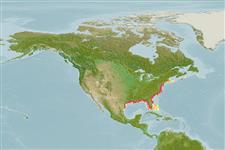Actinoptérygiens (poissons à nageoires rayonnées) >
Perciformes (Perch-likes) >
Blenniidae (Combtooth blennies) > Salariinae
Etymology: Hypsoblennius: Greek, hypsi = high + Greek, blennios = mucus (Ref. 45335).
Environnement / Climat / Gamme
Écologie
; marin récifal. Temperate, preferred ?; 46°N - 24°N
Western Atlantic: New Jersey (occasionally Nova Scotia in Canada) to Texas, including southern Florida in USA.
Taille / Poids / Âge
Maturity: Lm ? range ? - ? cm
Max length : 10.0 cm TL mâle / non sexé; (Ref. 7251)
Épines dorsales (Total): 11 - 13; Rayons mous dorsaux (Total): 13-16; Épines anales 2. Gill opening extending ventrally to opposite 7th-11th pectoral-fin ray; segmented dorsal-fin rays 13-16; segmented pelvic-fin rays 3; last dorsal-fin spine 8.5-15.5% SL; dorsal-fin spines robust and stiff; no elongate fleshy flap present posteriorly on lower lip; infraorbital bones 5-5; upper lip without free dorsal margin extending around snout; fleshy lobes of lower lip almost linear in lateral view and separated anterioventrally by a broad smooth area; bony interorbital width comparatively wider; dark spot usually present in spinous dorsal fin and centered on second spine; mandibular pores 4.
Adults inhabit oyster reefs and rocky shores. Oviparous. Eggs are demersal and adhesive (Ref. 205), and are attached to the substrate via a filamentous, adhesive pad or pedestal (Ref. 94114). Larvae are planktonic, often found in shallow, coastal waters (Ref. 94114).
Life cycle and mating behavior
Maturité | Reproduction | Frai | Œufs | Fécondité | Larves
Oviparous, distinct pairing (Ref. 205).
Robins, C.R. and G.C. Ray, 1986. A field guide to Atlantic coast fishes of North America. Houghton Mifflin Company, Boston, U.S.A. 354 p. (Ref. 7251)
Statut dans la liste rouge de l'IUCN (Ref. 115185)
CITES (Ref. 94142)
Not Evaluated
Menace pour l'homme
Harmless
Utilisations par l'homme
Pêcheries: sans intérêt
Plus d'informations
RéférencesAquacultureProfil d'aquacultureSouchesGénétiqueFréquences alléliquesHéritabilitéPathologiesTraitementMass conversion
CollaborateursImagesStamps, CoinsSonsCiguateraVitesseType de nageSurface branchialeOtolithesCerveauxVision
Outils
Articles particuliers
Télécharger en XML
Sources Internet
